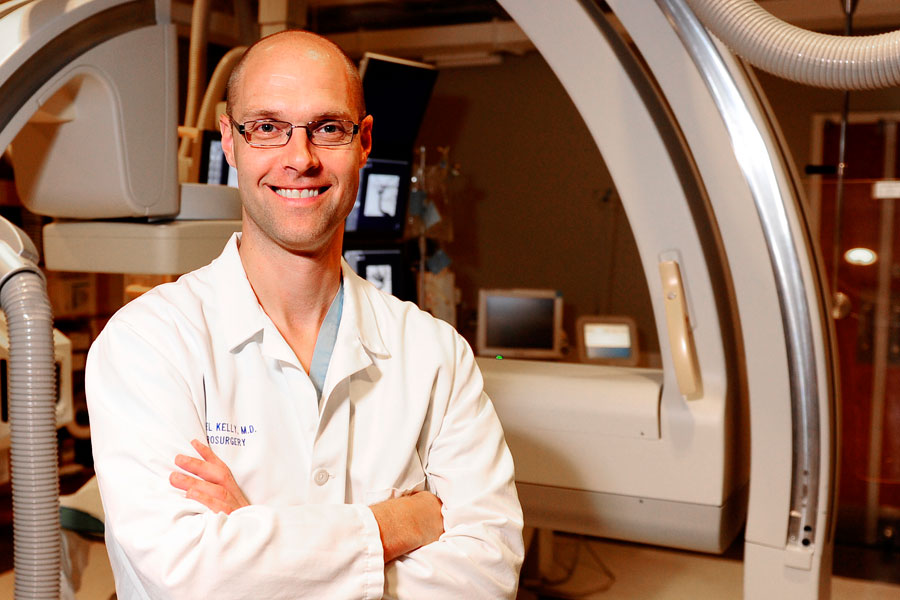
New clot-removal therapy benefits stroke patients
Dr. Michael Kelly has completed a medical trial at several sites around the world showing that a clot retrieval procedure known as endovascular treatment (ET) can dramatically improve patient outcomes after an acute ischemic stroke.
By Marg SheridanAn international team which includes University of Saskatchewan neurosurgeon Dr. Michael Kelly has completed a medical trial at several sites around the world showing that a clot retrieval procedure known as endovascular treatment (ET) can dramatically improve patient outcomes after an acute ischemic stroke.
“The Saskatoon Stroke Program team is honoured to be part of this landmark study for stroke care,” said Kelly, adding that ET techniques for the most severe forms of stroke are already offered at Royal University Hospital in Saskatoon. “This specialized care means we can save more lives and improve outcomes for stroke patients in Saskatchewan.”
The study, led by Drs. Michael Hill, Mayank Goyal and Andrew Demchuk at the Hotchkiss Brain Institute at the University of Calgary’s showed a dramatic improvement in outcomes and a reduction in deaths from stroke. The results are published in the New England Journal of Medicine (NEJM).
Overall, positive outcomes for patients increased from 30 to 55 per cent. In many cases, instead of suffering major neurological disability, patients went home to resume their lives. Mortality was cut in half, from two in 10 patients for standard treatment to one in 10 patients who received ET.
“Research is at the core of our race to save lives and create more survivors,” said David Sculthorpe, CEO of the Heart and Stroke Foundation of Canada. “A breakthrough like this will have an immediate impact, and it reminds us why the foundation is so committed to funding Canada’s best researchers —thanks to the generosity of our donors.”
Kelly is the Clinical Stroke Research Chair at the University of Saskatchewan’s College of Medicine, with a research program supported by the Saskatchewan Health Research Foundation and the Heart and Stroke Foundation of Canada. The foundation also funded the study itself, together with Alberta Innovates-Health Solutions and Medtronic, along with donations to the HBI Stroke Team and the Calgary Stroke Program.
“Ground-breaking studies such as these create transformative change and impact in health research and health care around the world”, said Patrick Odnokon interim CEO of the neurosurgeon. “The foundation is proud and pleased to provide support for outstanding researchers like Dr. Kelly, whose dedication to patient care will continue to impact so many lives.”
Ischemic stroke is caused by a sudden blockage of an artery to the brain. Currently, the international standard of care based on Canadian, U.S. and European guidelines is to administer tPA, a drug that dissolves the blood clot.
The trial was named ESCAPE (Endovascular treatment for Small Core and Anterior circulation Proximal occlusion with Emphasis on minimizing CT to recanalization times). In it, 316 patients who fit the criteria for ET and arrived for treatment within 12 hours of their stroke were randomized to standard medical care (which included tPA where appropriate) or standard medical care plus ET. The study included 22 sites in the U.S., U.K., Ireland and South Korea. Canada had 11 participating hospitals and enrolled two-thirds of the patients.
Guided by X-ray imaging, doctors perform ET by inserting a thin tube into the artery in the groin, through the body and into the brain blood vessels to the clot, which is then pulled out, restoring blood flow to the brain.
Although endovascular treatments were first developed in the 1990s, ET has only recently been technically possible. The ESCAPE team credits the success of the trial to very fast treatment and the use of brain and blood vessel imaging. In ESCAPE, researchers were on average two hours faster in opening the blocked blood vessels than in previously reported trials.
To read the full ESCAPE study visit U Calgary here.
